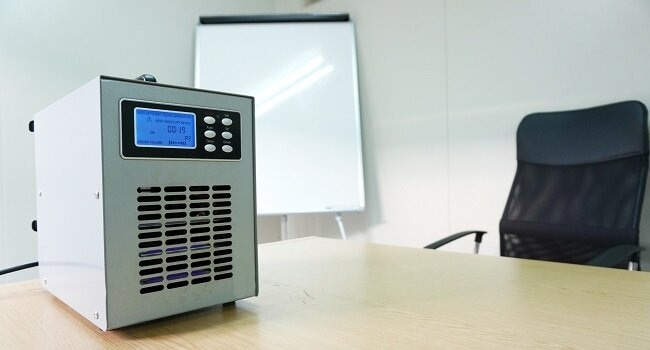Air filtration is helpful in maintaining a safe and healthy environment, particularly in healthcare facilities where vulnerable patients are treated. This is because the air quality within these facilities directly affects patient outcomes and healthcare workers’ overall well-being.
Exploring the importance and benefits of air filtration in healthcare facilities can help healthcare institutions choose the most effective system.
Airborne Pathogens And Healthcare-Associated Infections (HAIs)
Airborne pathogens and healthcare-associated infections (HAIs) present significant challenges within healthcare facilities, posing risks to patients and healthcare workers.
HAIs are infectious diseases that patients acquire during their stay in a hospital. These infections can lead to serious complications, increased healthcare costs, and even fatalities. Airborne transmission plays a significant role in spreading HAIs, making air filtration a critical factor in controlling their spread.
On the other hand, airborne pathogens commonly found in healthcare facilities include those that cause flu, pneumonia, and tuberculosis. These microorganisms can spread through the air and be inhaled by patients and staff, contributing to the transmission of infections.
Effective air filtration systems and smart sensor technology from Zeptive can significantly reduce the risk of exposure to these pathogens. However, to reduce infection rates and improve overall health outcomes, understanding the role of airborne transmission in spreading HAIs is a must, particularly in the implementation of effective air filtration systems. To choose suitable filtration systems that effectively combat these airborne threats in various healthcare settings, it would help to read through air purifier reviews first to determine the best types of units for the respective facilities.
Benefits of Effective Air Filtration in Healthcare Facilities
Healthcare facilities require an effective air filtration system to keep patients and workers safe. Efficient air filters offer the following benefits:
1. Reduced Transmission Of HAIs
One of the primary benefits of effective air filtration in healthcare facilities is the reduced transmission of HAIs. By capturing and removing airborne pathogens, air filtration systems help to minimize the risk of infections spreading through the air. This protects patients and healthcare workers who are exposed to these pathogens daily.
2. Improved Patient Outcomes
Effective air filtration has a direct impact on patient outcomes. A cleaner air environment reduces the likelihood of infection-related complications, resulting in shorter hospital stays and improved recovery rates. Furthermore, patients with compromised immune systems, such as those undergoing chemotherapy or organ transplants, are particularly vulnerable to infections. Efficient air filtration can provide an added layer of protection for these patients.
3. Protection For Healthcare Workers
Healthcare workers are constantly exposed to pathogens in their work environment, which puts them at risk for infection. By maintaining a high level of air quality through effective filtration, healthcare facilities can help protect their staff and reduce the risk of illness and absenteeism.
4. Enhanced Facility Reputation And Patient Satisfaction
A healthcare facility that prioritizes air quality and infection control is likely to have a better reputation among patients and the broader community. This can increase patient satisfaction and begin a chain of positive word-of-mouth referrals.

Types Of Air Filtration Systems For Healthcare Facilities
There are many types of air filtration systems suitable for healthcare facilities, such as the following:
1. Mechanical Filters
Mechanical filters are the most common air filtration system used in healthcare facilities. They physically trap particles in a filter medium, such as a HEPA (High-Efficiency Particulate Air) or ULPA (Ultra-Low Particulate Air) filter. HEPA filters are designed to capture at least 99.97% of particles 0.3 microns in size, while ULPA filters can capture at least 99.999% of particles 0.12 microns in size. These filters are particularly effective in removing airborne pathogens and allergens.
2. Electronic Filters
Electronic filters, including electrostatic precipitators and ionizers, use an electric charge to capture and remove particles from the air. Electrostatic precipitators apply a high voltage to a series of plates, attracting and capturing charged particles. Ionizers release ions into the air, which attach to airborne particles and make them easier to filter. Although electronic filters can be effective in the general filtration of dust and dander, they’re less efficient at capturing finer particles like smoke and viruses.
3. Ultraviolet Germicidal Irradiation (UVGI) Systems
UVGI systems use ultraviolet (UV) light to inactivate or kill microorganisms, thereby preventing their spread. In healthcare facilities, UVGI systems can be installed within the air handling system or used as stand-alone devices. They are particularly useful in controlling the spread of pathogens resistant to other filtration methods.
4. Gas-Phase Filters
Gas-phase filters are designed to remove gaseous pollutants from the air, such as volatile organic compounds (VOCs) and odors. These filters typically use activated carbon or other absorbent materials to capture and neutralize contaminants. Gas-phase filters can be beneficial in healthcare settings with strong odors or chemical fumes.
Conclusion
Effective air filtration systems can reduce the transmission of HAIs, improve patient outcomes, protect healthcare workers, and enhance the facility’s reputation. When selecting and implementing air filtration systems, healthcare facilities must consider factors such as facility size, patient population, budget, and regulatory compliance. As innovations continue emerging in this field, healthcare facilities must stay informed and adopt new technologies to improve air quality and patient care.
















